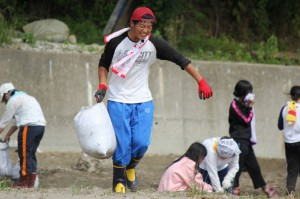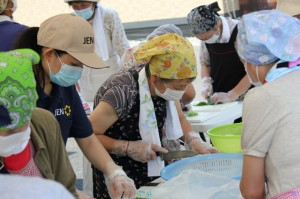By Miyako Hamasaka | Manager, External Relations
Project
Relief & Re-establishment for those affected by the Great Eastern Earthquake.
Target Area
Miyagi Prefecture, Ishinomaki City and nearby villages.
Activities during July, August & September
[Community Reconstruction]
JEN has continued to engage in Community Reconstruction primarily through the establishment of numerous centers of psycho-social care and interaction called “Community Spaces”. Two recent additions to JEN’s growing catalogue of completed spaces include “Hama-yu”, a pre-fab hut by the sea in Sasunohama village, and Koganehama Community Hall. Both function as platforms for social events that benefit the local community, as well as JEN’s base of operations for its various activities in the area, such as providing fishermen with fishing equipment and local communities with voluntary services.
As expressed by a participant at the inauguration ceremony of Hama-yu, the importance of such centers of social interaction cannot be understated in that there is a crucial need for communal spaces in which not only the long-term residents but also temporary evacuees and former inhabitants can mingle and strengthen relations. A similar sentiment was reiterated during a cooking event held after a disaster drill at a community hall, in which the general principles behind the selection process of temporary housing schemes were revealed to have been based on lottery and the avoidance of areas affected by the tsunami. Consequently, residents from different regions or hometowns became neighbors, and a need to cast aside background differences arose, as well as for the presence of shared spaces in which social interaction could be encouraged through workshops and other communal events, exemplified by the festival which took place in July in the fully renovated Koganehama Hall. Besides events initiated and organized by JEN, its staff and dispatched team of volunteers have participated in a handful of seasonal festivals, as well as commemorative events such as the Buddhist rites which took place at the opening of Ishinomaki port to pray for the repose of victims’ souls, in order to strengthen the already considerable bond it has fashioned with local communities.
[Mudbusters are turning into…]
Whilst JEN continues to recruit volunteers from the public, it has so far succeeded in dispatching over 4000 participants to sludge and debris removal operations. In recent months, we have also noticed a shift in emphasis from “emergency relief” type operations, such as the above, to “reconstruction assistance”, which focuses on social and economic rehabilitation, through the planned revitalization of key local industries. An example typifying both types of pursuits can be identified in the beach cleaning operation which took place at Shirahama, Jyusanhama District, on August 18th, 19th, 28th and 29th, conducted with the mid-term goal of the eventual reopening of the former bathing resort in sight. Amongst the 20 volunteers who joined us in cleaning up the beach every day was the large presence of junior high and high school students from all over the country.
In the hope of attracting visitors and contributing to the local economy, the Kitakami general branch office of municipal government have announced plans to erect an 8.4 meters high levee in January 2014, prior to reopening the beach, which formerly drew in over ten thousand beach-goers per year.
[Income Generation]
In disaster-struck communities with severely debilitated economies, income generation is arguably the most crucial factor in “reconstruction assistance”. In the case of Ishinomkai and its environs, this has chiefly taken on the form of fishery reconstruction, the area’s primary means of economy. As most harbour facilities and fishing equipment were devastated or swept away by the tsunami, the initial steps towards the recovery of the fishing industry are to supply the fishermen with necessary tools of their trade.
Working under the auspices of the Japan Fishery Cooperative Association, JEN has continued to provide fishery support in ten coastal areas, including a job creation project initiated in the four coasts of Omotehama, Higashihama, Urahama and Ishinomaki, distributing material required for the production of fishing nets, which are in turn manufactured by the local fishermen themselves. Such nets are but one amongst a growing list of equipment supplied by JEN to the local fishery, including skytanks, a forklift truck, palettes, a kelp cropping machine, plastic catch containers as well as the latest addition, a “dou”- a special trap to catch the congers that are in season now.
Another note-worthy contribution is the construction of prefabricated “Banya”s, or a fisherman’s lodge in the local vernacular, the first of which was constructed in Momoura, where 16 fishermen, living far from their workplaces in temporary or rented private houses, are attempting to recover the area’s coastal fishing, including some who commute eighty kilometers from Sendai city. The Banya will allow the fishermen to conduct a portion of their work and rest indoors, making a welcome change from previous conditions, especially in the adverse climates of summer and winter. Installation of Banya is scheduled to take place at five other locations.
JEN is committed to supporting the efforts of afflicted people to achieve self-reliance, and continues to recruit volunteers for its multifarious activities.
Links:
Project reports on GlobalGiving are posted directly to globalgiving.org by Project Leaders as they are completed, generally every 3-4 months. To protect the integrity of these documents, GlobalGiving does not alter them; therefore you may find some language or formatting issues.
If you donate to this project or have donated to this project, you can receive an email when this project posts a report. You can also subscribe for reports without donating.

